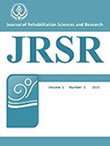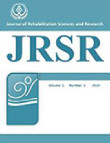فهرست مطالب

Journal of Rehabilitation Sciences and Research
Volume:4 Issue: 3, Sep 2017
- تاریخ انتشار: 1396/04/26
- تعداد عناوین: 5
-
-
Pages 61-65BackgroundAbdominal muscles are one of the most important components that provide trunk stability. It has been reported that abdominal muscles endurance can be decreased in patients with low back pain. Tests that can be used for the assessment of abdominal muscles endurance; include supine isometric chest raise (SICR) and supine double straight-leg raise (SDSLR) tests. The aim of this study is to investigate the effects of visual feedback and verbal encouragement on endurance tests of deep abdominal muscles.MethodsIn this two-factor mixed design study, a convenient sample of 40 asymptomatic (healthy) participants (20 males and females each) aged between 20-35 years was selected. Each subject performed the SICR and SDSLR tests under 4 conditions: no feedback, visual feedback, verbal encouragement, and combined visual feedback and verbal encouragement. The tests were terminated when the subject was no longer able to maintain a position. Furthermore, each test was repeated twice with 5 min interval and the average time was recorded for analysis.ResultsEndurance test time was improved significantly when 2 types of feedback were given during the tests (PConclusionThe incorporation of verbal encouragement and visual feedback is an important factor in improving holding time during endurance tasks. This may have important implications on endurance training and rehabilitation programmes of abdominal muscles.Keywords: Endurance test, Abdominal muscles, Visual feedback, Verbal encouragement
-
Pages 66-69BackgroundDevelopment of auditory differentiation skill plays an imperative role in the development of speech and language skills of children as well as central auditory processing. One of the instruments employed in the investigation of this skill is auditory differentiation test. The present study was conducted with the aim of investigating the auditory differentiation skill in normal 7-8 year old children.MethodsThe present cross-sectional descriptive study was performed on 200 normal girls and boys within the age bracket of 7-8 years with equal numbers of genders (100 girls and 100 boys). In order to examine the auditory differentiation skill, the Persian version of Wepman auditory differentiation test was employed. The significance level in this research was considered as P=0.05.ResultsThe auditory differentiation score according to percentiles of 5 and 95 was 38 and 40 among the seven year old group, respectively, while it was 38.05 and 40 in the eight year old group, respectively. The mean auditory differentiation score of the seven year old children was significantly lower than that of the eight year old children (P=0.04). No significant difference was observed between the two genders (P=0.19).ConclusionAccording to the results obtained in this research, the auditory differentiation score was significantly different between the seven and eight year old groups, but no significant difference was observed between boys and girls.Keywords: Auditory Differentiation, Central Auditory Processing, Rehabilitation, Auditory Perception
-
Pages 70-75BackgroundSit-to-stand motion is a frequent and challenging task in daily life activities especially for elderly and disabled people. Central nervous system uses several strategies for sit-to-stand movement. Many studies have been conducted to understand the underlying basis of the optimal approach. Reinforcement learning (RL) is a suitable method for modeling the control strategies that occur in neuro-musculoskeletal system.MethodsIn this paper a dynamic model of human sit-to-stand was derived, and kinematic data of a healthy subject has been extracted in this task. An optimal control problem was formulated considering minimum energy and Q-Learning method has been utilized to find the optimal joint moments during sit to stand movement.ResultsThe simulation results have been compared to the experimental data. The lower extremity joint angles have been simulated and tracked the actual human angles extracted from the experiments. Also the joints moments showed a satisfactory precision by the proposed approach.ConclusionAn RL-based algorithm was used to model the human sit-to-stand, in which the model explores the state space with a Markov based approach and finds the best actions (joint moments) at each state (posture). In this approach the model successfully performs the task while consuming minimum energy. This was achieved by updating the algorithm in every trial using a Q-learning method.Keywords: Sit-to-stand, optimal control, reinforcement learning, human dynamic model
-
Pages 76-83BackgroundIndividuals with spinal cord injury (SCI) lose their abilities to stand. The effectiveness of compensating strategies such as the use of various orthosis is studied by stability analysis. These kind of analyses are usually studied by linear method. In this study, the standing stability of complete and incomplete SCI individuals is evaluated by linear versus non-linear methods.MethodsStudy groups consisted of 10 normal, 5 incomplete and 5 complete SCI individuals. SCI participants stood with crutch and/or orthosis on a Kistler force plate. The excursions of center of pressure (COP), velocity of COP, correlation dimension, and approximate entropy in the anteroposterior and mediolateral planes were calculated in this study. Statistical analysis was done by one-way ANOVA and Post-hoc calculations by Tukey HSD.ResultsLinear method revealed that the difference in the mediolateral COP sway and anteroposterior COP velocity was insignificant among the groups, whilst the difference in anteroposterior COP sway, mediolateral COP velocity and total velocity was significant. In contrast, non-linear method revealed that the difference in mediolateral embedding diversion, anteroposterior embedding diversion, mediolateral correlation dimension and anteroposterior ApEn was insignificant among the groups, whilst the difference in anteroposterior correlation dimension and mediolateral ApEn was significant.ConclusionBased on linear method, the stability of SCI subjects seems to be like normal subjects. However, non-linear analysis revealed that although SCI patients knew how to put their body in a good posture to have a stable position, they had no abilities to control their posture.Keywords: Stability, Spinal Cord Injury, Linear Analysis, Non-Linear Analysis
-
Pages 84-87BackgroundProprioceptive inputs from the cervical region play an important role in balance. In patients with tension-type headache (TTH), proprioception is altered. The effect of treatment for TTH on balance is unclear. The aim of this study was to evaluate the effectiveness of post-isometric relaxation (PIR) in the neck muscles on pain, disability and balance in patients with TTH.Methods30 patients with chronic TTH who had a trigger point and tenderness in the upper trapezius, sternocleidomastoid (SCM), suboccipitalor splenius muscles were enrolled in the study. The patients underwent PIR based on Liebensons method. Before and after treatment, balancewas evaluated with the Y balance test, time up and go test, functional reach test and single leg stance test. As clinical symptoms of TTH we considered the intensity and frequency of headaches,which were recorded along with neck disability index (NDI)assecondary outcomes. Paired t-tests were used to analyze the data.ResultsThe results of the Y balance test, time up and go test, functional reach test and single leg stance test changed significantly after treatment (PConclusionsThe results of this study showed that the PIR technique for muscle relaxation in the upper trapezius, SCM, suboccipitalor splenius muscles may improve balance along with clinical symptoms such as pain and disabilityin patients with TTH.Keywords: Balance, Tension-type headache, Muscle relaxation, Disability


